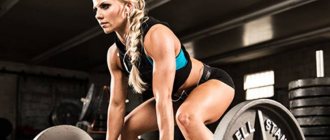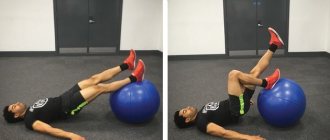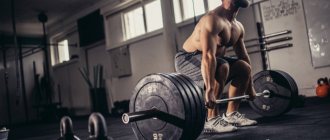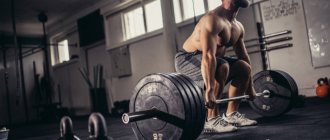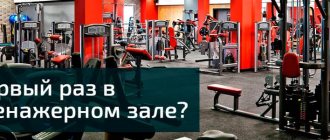01/23/202008/29/2018 from CulturFut
What is the best 5 day workout? How effective is this split training compared to the 3-day protocol, who is it best suited for and why. Also included are two 5-day split workout programs.
It is known that 3-5 days a week of training in the gym will help you achieve any of your fitness and bodybuilding goals.
Of course, this will all depend on how busy you are on a day-to-day basis, but over time, to get more out of your activities, take the time to implement a 5-day split. Below are two of what I believe are the best 5-day splits that you can incorporate into your training plan.
These workouts are not for beginners, but are suitable for athletes who have been training with iron for at least 2 years.
- Program No. 1
- 5 day split.
- Abs training.
- Explanation of the program.
- Cardio
- Question: Are 5-day splits more or less effective than 3-day splits?
- Who is this type of training best suited for?
- Program No. 2
- Bottom line.
5 day split.
This 5-day split will look like this:
- Day 1: Legs/Abs
- Day 2: Chest
- Day 3: Back/Abs
- Day 4: Rest
- Day 5: Shoulders/Abs
- Day 6: Hands
- Day 7: Rest
Note. The reasons for assigning these muscle groups in this order are as follows: For most athletes, lower extremity training is likely the hardest.
Therefore, it is extremely important to target this large muscle mass at the beginning of each week to ensure that the workout is done at full capacity while the body is still fresh.
Also, instead of training five days in a row, it is useful to take a rest day between some training days, so to speak in the middle of the split, so that the central nervous system can get proper recovery.
This is especially important for those who have just switched to a five-day workout, and their body is not yet prepared to work at high intensity for five days in a row.
Finally, it is more optimal to space out the training of the shoulders and arms from the training of the chest and back, as much as possible, so that the deltoids, biceps and triceps can recover normally.
At each workout you should perform 4-5 basic exercises and 2-3 auxiliary exercises.
Things to consider during training:
- Perform the first exercise for each muscle group as a rest-pause, resting 10-15 seconds between sets. Before this, do 3 warm-up approaches with a gradual increase in weight. You should also perform 2 warm-up sets before each basic exercise. In the program, in addition to the first exercise for a muscle group, only working approaches are indicated!
- Rest between sets should be in the range of 60-90 seconds, between exercises no more than 2 minutes.
- Since 5-day splits can be very taxing on your muscles and the body as a whole, it is important to stay hydrated during your workout and consume BCAAs and sports protein shakes to replenish your muscle glycogen stores.
- Select a weight that you can work with without cheating.
- Each repetition is performed through a full range of motion unless otherwise noted.
- Before each workout, do a general warm-up.
- After training, perform a set of exercises to stretch the trained muscle.
Day – 1: leg training.
1. Barbell squats – 3 warm-up sets of 8 reps and 5 working sets of 4, 3, 2, 2, 1 reps (rest-pause)
Superset:
2A. Leg press – 3, 4 sets of 8-10 reps.
2B. Leg bending while sitting on a machine – 3, 4 sets of 8-10 repetitions.
Normal execution:
3. Leg extension in the simulator - 3, 4 sets of 12-15 repetitions.
4. Standing calf raises in the gym – 3, 4 sets of 12-15 repetitions.
Day – 2: chest workout.
1. Incline bench press – 3 warm-up sets of 8 reps and 5 working sets of 4, 3, 2, 2, 1 reps (rest-pause)
Superset:
2A. Dumbbell bench press on a horizontal bench – 3, 4 sets of 8-10 repetitions.
Read also: Stretching: 5 essential exercises.
2B. Dumbbell flyes on a horizontal bench – 3.4 sets of 8-10 reps.
Normal execution:
3. Reduction of arms in the butterfly simulator - 3 sets of 12-15 repetitions.
4. Pullover over a bench with dumbbells – 3 sets of 12-15 repetitions.
Day – 3: back training.
1. Pull-ups – 3 warm-up sets without weight and 5 working sets of 4, 3, 2, 2, 1 reps (rest-pause)
Superset:
2A. Bent-over barbell rows – 3, 4 sets of 8-10 reps.
2B. Straight arm pull-down while standing – 3, 4 sets of 8-10 reps.
Normal execution:
3. Close-grip lat pull-down – 3 sets of 12–15 reps.
4. Deadlift – 3 sets of 12-15 reps.
Day – 4: rest.
Day – 5: shoulder training.
1. Shwung press with a barbell – 3 warm-up sets of 8 reps and 5 working sets of 4, 3, 2, 2, 1 reps (rest-pause)
Superset:
2A. Vertical barbell row – 3, 4 sets of 8-10 reps.
2B. Lateral dumbbell raise lying sideways on an incline bench – 3, 4 sets of 8-10 repetitions.
Normal execution:
3. Lifting dumbbells in front of you while standing – 3 sets of 12-15 repetitions.
4. Bent-over crossover raises from lower blocks – 3 sets of 12-15 repetitions.
Day – 6: arm training.
1. Curling arms with a barbell on a Scott bench - 3 warm-up sets of 8 reps and 5 working sets of 4, 3, 2, 2, 1 reps (rest-pause)
Superset:
2A. French barbell press on a bench with a negative incline - 3, 4 sets of 8-10 repetitions.
2B. Raising dumbbells for biceps “hammer” - 3, 4 sets of 8-10 repetitions.
Normal execution:
3. Dips – 3 sets of 12-15 reps.
4. Barbell curls for biceps – 3 sets of 12-15 repetitions.
Day – 7: rest.
Friday
- We start with push-ups, 15 times.
- Gluteal bridge, 1 min.
- Plank, 1 min.
- Superman. Lie flat on your stomach and simultaneously lift your legs and arms up. Perform 20 lifts.
- Cat. Get on all fours and, as you inhale, pull in your stomach, raising your back up; as you exhale, bend your lower back and relax your stomach.
- Burpees, 15 times.
- Lie on your stomach again, bend your elbows and spread them to the sides, then lift your chest up. This exercise works the lower back.
Perform 2-3 sets of this workout.
Abs training.
While there are many ways to work your abdominal muscles, I find that a mixture of resistance exercises (heavy movements) and bodyweight exercises (light movements) produces the best results.
A common mistake that many athletes make is to perform high repetitions of crunches and side bends in order to burn fat around the abdominal area. Diet and proper nutrition are the key to a firm and defined belly!
Let's pump up the press.
1. Crunches lying on the floor with extra. weights – 5 sets of 15 repetitions.
Superset:
2A. Raising straight legs while lying on a horizontal bench – 3 sets of 12-15 repetitions.
2B. Crunches on the upper block “prayer” - 3 sets of 12-15 repetitions.
Normal execution:
3. Plank – 3 sets to failure.
The most common exercises
Jumping jacks:
1. Stand straight, feet together, arms down, back straight.
2. Jump with your legs and arms wide apart, then return to the starting position and jump again.
Burpee (burpee):
- Stand straight, feet side by side, back straight.
- Squat down until your palms touch the surface, then get into a push-up stance.
- Return to the squat position and jump up as hard as you can.
Mountain Climber (climber):
- Get into a push-up position and then move your legs toward your chest one at a time.
Plank:
- Get back into a push-up position.
- Go down to your elbows, pull in your stomach and stand in this position, the main thing is to avoid arching your lower back and do not lift your hips up.
Explanation of the program.
Every three weeks, for the first exercise for each muscle group, change the exercise itself or the execution method (or both). For example, instead of using a rest-pause technique for squats, you can choose a heavy eccentric, where you set the barbell weight to about 110% of 1RM and lower it for a certain period of time (about 4-5 seconds) i.e. working on lowering.
For other exercises, you can also choose different variations, increase training volume and/or change the number of sets/reps, but keep the same number of total reps.
For example, if you decide to do 3x8 for the leg press (24 reps total), you can increase the weight and do sets/reps of 4x6 (still 24 reps) or increase the total volume (tonnage) to 4x10.
Where to begin?
The best way to find out if the 5x5 program will make you stronger is to try it for 12 weeks. Start with the following steps:
- Watch this video and you will see that the program is so simple that anyone can follow it.
- Use my charts - it will motivate you and let you see how much stronger you will be in 12 weeks.
- Choose a gym - all you need is a power rack, a bench, a bar and weight plates.
- Install the “5x5” application - it will show you which exercises to perform and with what weight, as well as how long to rest between approaches. It is free and suitable for iPhone and Android OS.
- Take advantage of my daily tips - many guys read my daily motivational letters first thing in the morning. They claim that this helps them stay on track and continue going to the gym. You can find my tips here.
Apply the acquired knowledge in practice. Only through action will you become stronger.
Cardio
While I'm not a fan of doing cardio during the muscle-building phase (mostly because it makes it a little more difficult), I do think cardio sessions can be beneficial.
For those who prefer to do cardio, do it twice a week. A 30-minute run on a track or open area, or 15-20 minutes of interval cardio, will help burn excess calories. If you play sports games like basketball, soccer, volleyball, etc., I would use them as your main cardio activity and not do anything additional beyond that.
Read also: Get Strong: Follow this program to increase your strength.
Nutrition and diet tips
The most effective way to combine this training regimen is with nutrition to gain pure muscle mass. It will be easier to burn some fat afterward than to try to build muscle while lacking calories or, on the contrary, to gain on junk food such as sweets and fast food.
If you want to consistently gain weight and don't know how to increase your caloric intake, here is a list of foods that will allow you to do this without compromising your health:
- buckwheat
- rice
- durum pasta
- oatmeal
- eggs
- any chicken meat
- veal
- pork is not fatty
- any fish
- vegetables, the more the better
- oil (natural 82%)
- cream cheese
- sour cream
- whole milk
- heavy cream
- any cheese
- protein shakes
- peanut butter
- olive oil
- additional sauces and dressings
This will make your food tastier and enrich it with healthy fats. I prefer to fill the calorie deficit this way, instead of going to McDonalds and stocking up on several burgers at a time.
Your health will improve, you will become more alert and energetic, and your stomach will thank you.
Note: These products have significant energy value. Therefore, try not to overdo it, and clearly calculate the required number of calories.
Question: Are 5-day splits more or less effective than 3-day splits?
It will depend on the person. For some, 5 days a week is too much, and for others, too little. But for most people whose goal is to increase muscle mass, 5-day splits are much better.
The 3-day split is primarily used for strength work, with heavy weights, where the athlete needs enough time to fully recover his muscular and nervous systems.
On the other hand, a 5-day split allows the athlete to work consistently and in detail on each muscle group with greater intensity, which in turn stimulates their active growth. Plus, training five days a week will burn more calories than training three days a week.
3-day workouts are well suited for those who are just starting to lift weights. Full Body style training or upper-lower-upper body in the first training week and lower-upper-lower body in the second. Over the next 3-4 weeks the cycle repeats.
This type of training will help prepare your muscles and central nervous system for more challenging 5-day workouts.
How long does it take for muscles to recover?
Scientific research suggests that the time required for muscle recovery after exercise is on average 48 to 72 hours - or 2 to 3 days. In reality, this figure depends both on the level of experience of the athlete and his age (the older the person, the longer the recovery takes), and on which muscles were involved in the training.
Moreover, if small and medium muscle groups (for example, arms, shoulders and abs) require about 48 - 60 hours for regeneration, then for the full restoration of large muscles (primarily legs, chest, back), and, in particular, the central nervous system , also experiencing severe stress when performing basic exercises, needs at least 72 hours(1).
Recovery time for muscle groups
| Shoulders | 48 – 60 hours |
| Breast | up to 72 hours |
| Back | up to 72 hours |
| Press | 48 – 60 hours |
| Triceps | 48 – 60 hours |
| Biceps | 48 – 60 hours |
| Buttocks | up to 72 hours |
| Thigh muscles | up to 72 hours |
| Caviar | 48 – 60 hours |
Who is this type of training best suited for?
Almost all athletes whose goal is to gain muscle mass can use this type of training. However, 5-day splits are more likely to benefit a more experienced athlete than someone who has just started training because the muscles, ligaments, joints and central nervous system of an experienced athlete are better equipped to handle the 5-day load placed on them. body.
The athletes who will benefit most from this type of training will be those whose goal is only to improve their strength in heavy one-rep lifts.
Training five days a week causes powerlifters to overtrain because they do not have adequate recovery time.
For those whose goal is fat loss, 5-day splits are definitely a good choice. By training five days a week (along with cardio), athletes will burn a lot of calories and thus burn fat.
5-day workouts can be used for both bulking and relief training (taking into account proper nutrition). As you can see, this type of split is universal, as it allows you to choose different methods and exercises for training.
Compliance with the sports regime
To achieve the desired result, you need to strictly adhere to a sports regime, which consists of three components: training, nutrition and rest. Each of these elements is very important and without one of them the result is impossible. Training should be as productive as possible, you should give your best in training and push your muscles to failure. Muscles destroyed during training need building material, which we get from food.
Nutrition must be balanced; for constant growth, you need to consume more calories than you burn. The main sources of nutrients should be cereals, meat, and dairy products. Muscles do not grow during training, but during rest, so this is one of the most important elements; a person rests during sleep; sleep must last at least eight hours for the muscles to fully recover. By following a sports regime, you will definitely get the result you wanted when you came to the gym.
Program No. 2
I've been training 5 days a week quite often and have found this split to be the best from a recovery/strength/volume standpoint. I'm a big fan of both the deadlift and the squat, and both are very important to me.
In this version of the 5-day split, I try to spread out the back training and the leg training as much as I can so that I can perform both exercises with full dedication and have time to recover from them.
This 5-day split will look like this:
- Day – 1: Chest/Abs
- Day 2: Back
- Day 3: Rest.
- Day 4: Shoulders/Abs
- Day 5: Legs
- Day 6: Arms/Abs
- Day 7: Rest.
For each exercise, the range of approaches is 3-4. For strength movements (squats, deadlifts, presses) I keep my rep range low and usually do 4x6, 3x8, or 10,8,6. Each subsequent exercise varies sets from 12,10,8 reps to 3x12 and 3x8. I typically perform about 15-18 total sets per muscle group.
This rep scheme leaves your body and muscles in “guessing mode” to avoid plateaus and overtraining later on.
Day – 1: chest and abs workout.
- Bench press on a horizontal bench – 3 sets of 6-10 reps.
- Incline bench press – 3 sets of 8-12 reps.
- Reverse incline bench press – 3 sets of 8-12 reps.
- Dumbbell flyes on a horizontal bench – 3 sets of 8-12 reps.
- Reduction of arms in a crossover from the upper blocks - 3 sets of 8-12 repetitions.
- Crunches lying on the floor - 3 sets of 12-15 repetitions.
- Leg raises hanging on the horizontal bar - 3 sets of 12-15 repetitions.
- Crunches from the upper block while on your knees - 3 sets of 12-15 repetitions.
Read also: Full body workout for women at home.
Day – 2: back training.
- Deadlift – 4 sets of 6-10 reps.
- Wide grip pull-ups – 3 sets of 8-12 reps.
- T-bar rows – 3 sets of 8-12 reps.
- Bent-over dumbbell rows – 3 sets of 8-12 reps.
- Wide grip lat pulldown – 3 sets of 8-12 reps.
- Barbell shrugs – 3 sets of 8-12 reps.
Day – 3: rest.
Day – 4: shoulder and abs workout.
- Standing barbell press – 4 sets of 6-10 reps.
- Vertical barbell row – 3 sets of 8-12 reps.
- Arnold press – 3 sets of 8-12 reps.
- Bent-over dumbbell raises – 3 sets of 8-12 reps.
- Standing dumbbell lateral raises – 3 sets of 8-12 reps.
- Crunches lying on the floor - 3 sets of 12-15 repetitions.
- Leg raises hanging on the horizontal bar - 3 sets of 12-15 repetitions.
- Crunches from the upper block while on your knees - 3 sets of 12-15 repetitions.
Day – 5: leg training.
- Barbell squats – 4 sets of 6-10 reps.
- Leg press – 3 sets of 3 sets of 8-12 reps.
- Barbell lunges – 3 sets of 8-12 reps.
- Leg extension in the simulator - 3 sets of 8-12 repetitions.
- Leg curls in the simulator - 3 sets of 8-12 repetitions.
- Standing calf raises – 3 sets of 8-12 reps.
- Calf raises while sitting in a machine – 3 sets of 8-12 repetitions.
Day – 6: arm and abs workout.
- Close grip barbell press – 4 sets of 6-10 reps.
- French bench press – 3 sets of 8-12 reps.
- Extension of arms from behind the head from the lower block while standing – 3 sets of 8-12 repetitions.
- Reverse-grip lat pull-downs or reverse-grip pull-ups – 3 sets of 8-12 reps.
- Barbell curls for biceps – 3 sets of 8-12 reps.
- Lifting dumbbells for biceps while lying on an incline bench - 3 sets of 8-12 repetitions.
- Reverse grip barbell curls – 3 sets of 8-12 reps.
- Standing wrist curls with a barbell behind your back – 3 sets of 8-12 reps.
- Crunches lying on the floor - 3 sets of 12-15 repetitions.
- Leg raises hanging on the horizontal bar - 3 sets of 12-15 repetitions.
- Crunches from the upper block while on your knees - 3 sets of 12-15 repetitions.
Day – 7: rest.
As you can see, there are many options to choose from when you work on a 5-day split. Use different techniques and exercises from time to time and try something new. When you find one that works for you, stick with it. When it stops producing results, find a new one.
Warm-up
Training program for 5 days:
- Stand up straight, tilt your head forward, backward, right, left, and then rotate your head in a circle. Do 5-10 tilts and 10 rotations.
- Rotate back and forth in a circle, first with one hand, then with the other, and finally with both. Keep your arms straight. 10-15 times will be enough.
- Rotate your hands in a circle, first in one direction, then in the other, or clasp your hands together and do all of the above.
- Take an even stance and turn to the right 10 times and to the left the same number. This warms up the back muscles well. And then bend your torso forward, while stretching your arms towards the floor as much as possible.
- Pelvic rotation. Everything is clear here, this exercise also warms up your back, do 15 circular rotations in different directions.
- From a level stand, rise onto your toes and stretch your arms towards the sun, or towards the chandelier. Perform 20 of these lifts.
- Shift your weight onto one leg and rotate the other in clockwise and counterclockwise circles. Also perform 20 rotations with each leg.
- Jump in place 10 times, and then make the exercise more challenging by raising your knees toward your chest as you jump.
- Sit on the surface, straighten your legs and try to fold yourself like a book, reaching your hands towards your heels.
- Remaining in a sitting position, spread your legs to the sides and now stretch your chest towards the floor, hold for 30 seconds.
Bottom line.
Five-day workouts are generally suitable for training one muscle group per week. This allows you to break up your workouts by muscle group and work them fully, and then you have six days to fully recover for your next workout. Recovery is key in bodybuilding, which helps prevent overtraining.
I find that a 5-day split is more effective than a 3-day or even a 4-day split. I got the best results from 5 days of training. This allowed me to focus on one muscle group each workout and work on it as closely as possible.
As mentioned, 3-day workouts are great for beginners, but for the more experienced athlete who knows that a 5-day split will allow him to fully exhaust his muscles once a week with high-intensity training and then fully recover, it is better This type of training is most suitable.
On top of that, if you don't have a lot of time and can't spend five days a week at the gym, you may have to opt for the 3-day split option.
Recommended Supplements
Without proper nutrition, any supplements and sports nutrition turn into a waste of money . I'll probably be the first to advise choosing a can of protein over a couple of kilos of good meat. But I hope that you already know this without me.
For those who do not have problems with the diet, below I provide a list of supplements that enhance the effects of this training method.
Pre-workout supplements
I prefer to train with pretrains while cutting, because with a low calorie diet, I no longer have the strength to maintain the normal intensity of the workout. But when gaining mass, you also need to give it your all, and if you are natural, then you also invest in 1 hour, the maximum is to finish the workout in 1 hour and 20 minutes.
Choose a blend that is moderate in stimulants.
Protein
In my opinion, the most pleasant-tasting protein is strawberry or babana. And there you can safely take it without additives. Oh yes, by company, take any from a store you trust. I personally prefer Optimum Nutrition. But you can take another brand of whey concentrate; this is the best option in terms of price-quality ratio.
The most optimal composition without any “surprises” in the form of an imaginary increased content of amino acids, which are easily digestible, or a large amount of fat with carbohydrates, which are already sufficient in the diet.
Calculation of the daily requirement should be done based on your protein requirement for the day and the amount you get from food. Personally, I drink one or two scoops in the morning and the same amount after training.
BCAAs
I use this supplement in the morning and after training, and can also take it on time if I haven't eaten well that day. It helps keep muscles from breaking down, especially in the morning and after exercise when cortisol levels rise. You can take from 5 to 30 grams. In essence, this is the same protein, but very quickly digested, which will enter the bloodstream faster than protein from chicken breast or even eggs. If money is tight, you can do without it.
Creatine
I have already written about him. This proven and effective sports nutrition will help you train harder and recover more effectively. Highly recommend . Beginners can start using it no earlier than after half a year of training, or better yet, after a year. This way you will accelerate your body’s own potential and then strengthen your capabilities. It can be taken 5 grams on an empty stomach with grape juice or honey. I personally take it in cycles, as it seems to me that it works better this way.



